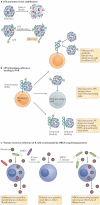The influence of commensal bacteria on infection with enteric viruses
- PMID: 26853118
- PMCID: PMC5198578
- DOI: 10.1038/nrmicro.2015.25
The influence of commensal bacteria on infection with enteric viruses
Abstract
The intestinal microbiota exerts a marked influence in the mammalian host, both during homeostasis and disease. However, until very recently, there has been relatively little focus on the potential effect of commensal microorganisms on viral infection of the intestinal tract. In this Progress article, I review the recent advances that elucidate the mechanisms by which enteric viruses use commensal bacteria to enhance viral infectivity. These mechanisms segregate into two general categories: the direct facilitation of viral infection, including bacterial stabilization of viral particles and the facilitation of viral attachment to host target cells; and the indirect skewing of the antiviral immune response in a manner that promotes viral infection. Finally, I discuss the implications of these interactions for the development of vaccines and novel therapeutic approaches.
Figures




References
Publication types
MeSH terms
Substances
Grants and funding
LinkOut - more resources
Full Text Sources
Other Literature Sources
Medical

